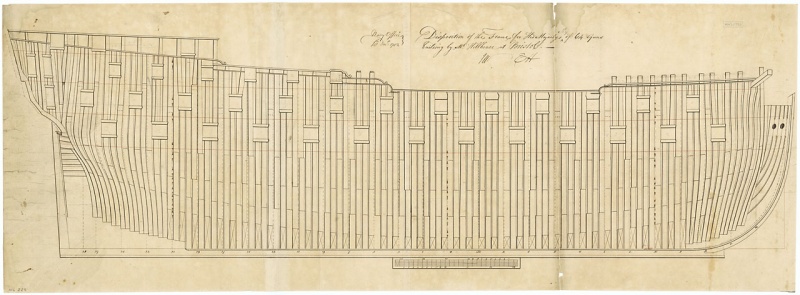HMS Nassau (1785)
Silhouette of the ship of the line Nassau.
HMS Nassau was a Slade designed, Ardent Class, 64 gun third rate ship of the line, built by James Martin Hillhouse at Bristol. Ordered on the 14th of November 1782, and laid down in the March of 1783, she was launched on the 28th of September, 1785, and completed between the 8th of November of that year and the second of February, 1786, at Bristol, and then coppered at Plymouth.

History GREAT BRITAIN Name: HMS Nassau Ordered: 14 November 1782 Builder: Hillhouse, Bristol Laid down: March 1783 Launched: 20 September 1785 Fate: Wrecked 14 October 1799
General characteristicsClass and type: Ardent Class ship of the line Tons burthen: 1384 (bm) Length: 160 ft 1 in (49 m) (gundeck) Beam: 44 ft 5 in (13.51 m) Depth of hold: 19 ft 1 in (5.8 m) Propulsion: Sails Sail plan: Full rigged ship Armament:
- 64 guns:
- Gundeck: 26 × 24-pounder guns
- Upper gundeck: 26 × 18-pounder guns
- QD: 10 × 4-pounder guns
- Fc: 2 × 9-pounder guns
Service.
HMS Nassau was commissioned in the July of 1790 under Captain Andrew Southerland for the Spanish Armament, fitted at Plymouth and then paid off. She was recommissioned in the March of 1795 under Captain Herbert Sawyer, who commanded her until the spring of 1797, for duty in the North Sea.
‘Hand-coloured etching (July 1797) of Richard Parker, President of the Delegates in the Mutiny at the Nore.
During the Mutiny at the Nore led by Richard Parker between the 26th of May and the 13th of June, she was commanded by Captain Edward O’Bryen, and under him went on to become the Flagship of Vice Admiral Sir Richard Onslow. On the outbreak of the mutiny, his authority was challenged and resisted by his crew. When they attempted to hang two men who would not join them, O'Bryen insisted that if anyone should die he would be the first and threatened to throw himself overboard. This checked the actions of the mutineers, but reportedly O'Bryen was left close to suicide. He left the ship shortly afterwards, and although the crew, who expressed their affection for him, invited him to return, he refused until the mutiny was over. In July, Onslow and O'Bryen moved to HMS Monarch and Nassau then came under the command of Captain William Hargood. Between the June and July of 1799 she was converted for use as a troopship at Chatham for £2,010, the command then passing to Captain George Tripp.
Fate.
Nassau was wrecked on the Haak sands off the Texel, the Netherlands, on the 14th of October, 1799. 205 members of her crew survived, out of a total of approximately 400.








Bookmarks